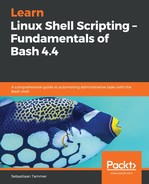At the beginning of this chapter, we presented you with something to think about: asking the user to agree or disagree with something by stating yes or no. As we discussed, there are many possible answers we can expect a user to give. Realistically, there are five ways a user could give us a yes: y, Y, yes, YES, and Yes.
The same goes for no. Let's see how we could check this without using any tricks:
reader@ubuntu:~/scripts/chapter_09$ vim yes-no.sh
reader@ubuntu:~/scripts/chapter_09$ cat yes-no.sh
#!/bin/bash
#####################################
# Author: Sebastiaan Tammer
# Version: v1.0.0
# Date: 2018-10-01
# Description: Dealing with yes/no answers.
# Usage: ./yes-no.sh
#####################################
read -p "Do you like this question? " reply_variable
# See if the user responded positively.
if [[ ${reply_variable} = 'y' || ${reply_variable} = 'Y' || ${reply_variable} = 'yes' || ${reply_variable} = 'YES' || ${reply_variable} = 'Yes' ]]; then
echo "Great, I worked really hard on it!"
exit 0
fi
# Maybe the user responded negatively?
if [[ ${reply_variable} = 'n' || ${reply_variable} = 'N' || ${reply_variable} = 'no' || ${reply_variable} = 'NO' || ${reply_variable} = 'No' ]]; then
echo "You did not? But I worked so hard on it!"
exit 0
fi
# If we get here, the user did not give a proper response.
echo "Please use yes/no!"
exit 1
reader@ubuntu:~/scripts/chapter_09$ bash yes-no.sh
Do you like this question? Yes
Great, I worked really hard on it!
reader@ubuntu:~/scripts/chapter_09$ bash yes-no.sh
Do you like this question? n
You did not? But I worked so hard on it!
reader@ubuntu:~/scripts/chapter_09$ bash yes-no.sh
Do you like this question? maybe
Please use yes/no!
While this works, it is not really a very workable solution. Even worse, if the user happens to have Caps Lock on while they're trying to type Yes, we will end up with yES! Do we need to include that as well? The answer is, of course, no. Bash has a nifty little feature called parameter expansion. We will explain this in much more depth in Chapter 16, Bash Parameter Substitution and Expansion, but for now, we can give you a preview of what it is capable of:
reader@ubuntu:~/scripts/chapter_09$ cp yes-no.sh yes-no-optimized.sh
reader@ubuntu:~/scripts/chapter_09$ vim yes-no-optimized.sh
reader@ubuntu:~/scripts/chapter_09$ cat yes-no-optimized.sh
#!/bin/bash
#####################################
# Author: Sebastiaan Tammer
# Version: v1.0.0
# Date: 2018-10-01
# Description: Dealing with yes/no answers, smarter this time!
# Usage: ./yes-no-optimized.sh
#####################################
read -p "Do you like this question? " reply_variable
# See if the user responded positively.
if [[ ${reply_variable,,} = 'y' || ${reply_variable,,} = 'yes' ]]; then
echo "Great, I worked really hard on it!"
exit 0
fi
# Maybe the user responded negatively?
if [[ ${reply_variable^^} = 'N' || ${reply_variable^^} = 'NO' ]]; then
echo "You did not? But I worked so hard on it!"
exit 0
fi
# If we get here, the user did not give a proper response.
echo "Please use yes/no!"
exit 1
reader@ubuntu:~/scripts/chapter_09$ bash yes-no-optimized.sh
Do you like this question? YES
Great, I worked really hard on it!
reader@ubuntu:~/scripts/chapter_09$ bash yes-no-optimized.sh
Do you like this question? no
You did not? But I worked so hard on it!
Instead of five checks for each answer, we now use two: one for the full word (yes/no) and one for the short one-letter answer (y/n). But, how does the answer YES work, when we have only specified yes? The solution to this question lies in the ,, and ^^, which we have included inside the variable. So, instead of ${reply_variable}, we used ${reply_variable,,} and ${reply_variable^^}. In the case of ,,, the variable is first resolved to its value and then converted to all lowercase letters. Because of this, all three answers – YES, Yes, and yes – can be compared with yes, as that is how Bash will expand them. You might take a guess at what ^^ does: it converts the content of the string to uppercase, which is why we can compare it to NO, even though we give the answer no.
